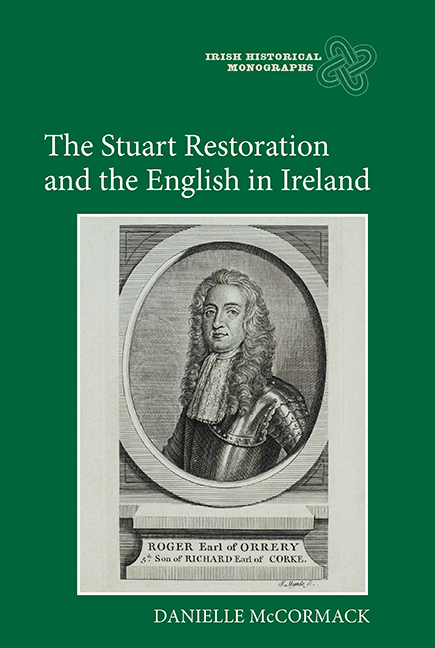Book contents
- Frontmatter
- Contents
- Miscellaneous Frontmatter
- Acknowledgements
- List of abbreviations and conventions
- Introduction
- 1 The political and mental map of 1660s Ireland
- 2 Stuart restoration and the beginnings of Protestant discontent
- 3 Roger Boyle, earl of Orrery, and the evolution of English Protestant identity in Ireland
- 4 Moral and rhetorical challenges to Protestant power
- 5 Charles II and his ministers in Ireland
- 6 The court of claims, popery and Stuart authority
- Conclusion
- Bibliography
- Index
- Frontmatter
- Contents
- Miscellaneous Frontmatter
- Acknowledgements
- List of abbreviations and conventions
- Introduction
- 1 The political and mental map of 1660s Ireland
- 2 Stuart restoration and the beginnings of Protestant discontent
- 3 Roger Boyle, earl of Orrery, and the evolution of English Protestant identity in Ireland
- 4 Moral and rhetorical challenges to Protestant power
- 5 Charles II and his ministers in Ireland
- 6 The court of claims, popery and Stuart authority
- Conclusion
- Bibliography
- Index
Summary
In May 1660, the exiled King Charles II was restored to his Irish, English and Scottish kingdoms. His restoration ushered in a period in which competing interests jostled for reward and sought vengeance for perceived wrongs suffered during the wars that had engulfed Britain and Ireland since 1638. Ireland was the site of particular bitterness. Its landscape was ravaged by warfare while its inhabitants were preoccupied with memories of the bloodshed and suffering of the previous two decades. Oliver Cromwell's conquest of the kingdom by 1652 had led to a massive transfer of land and power from Catholics to Protestants. The most recent analysis of the mid-seventeenth-century land transfer asserts that in 1641, 1,756 Catholics possessed 66% of all land. By c.1675, 1,353 Catholics held only 29%. In 1660, the latter, from a position of power, sought to maintain the great gains that they had made. Meanwhile, Catholics attempted to compel the king to honour commitments made to them by his lord deputy, James Butler, marquess of Ormond, in the 1640s, particularly those contained in the 1649 Articles of Peace, which he had concluded with the Catholic Confederation of Kilkenny.
Politics in Ireland against the background of the Stuart restoration were conducted along an axis of Protestant versus Catholic, or English Protestant versus Irish Catholic. However, these confessional and national categories masked a variety of competing interests. The terms of debate were simplistic and simplifying, but they were accepted by political agents and served the purpose of unifying fragile alliances. In reality, the well-connected of both the Protestants and Catholics survived and thrived while the less fortunate of both denominations were victims of others’ aggrandisement. The settlement of Ireland on an English Protestant or Irish Catholic interest was as much the story of the personal enrichment of cunning and powerful men as it was the story of the victory or vanquishment of one group or the other. Yet the rhetoric of maintenance of Protestantism in Ireland or of justice for Catholics provided the fuel of politics. It animated debate in both print and oral forms and shaped contemporary understandings of the outcome of the settlement.
Restoration Ireland was a period in which return of monarchy represented an opportunity to recast power in the kingdom. Capture of governance would be key to any attempt to reconfigure Irish politics and society.
- Type
- Chapter
- Information
- Publisher: Boydell & BrewerPrint publication year: 2016



